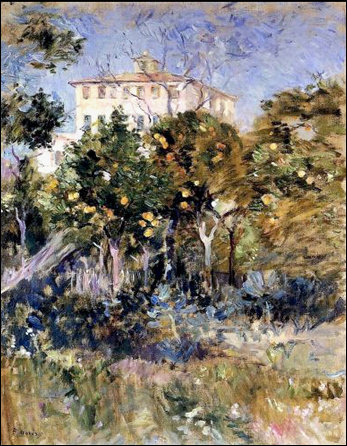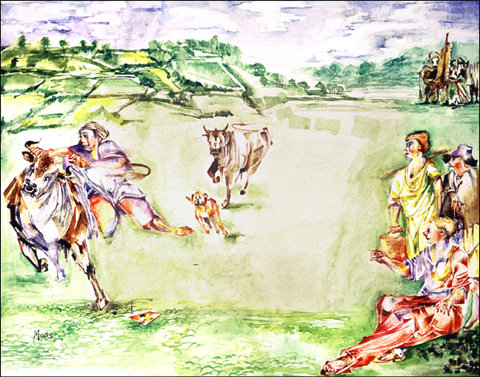Creating a permanent record en plein air of the Riviera landscape
Berthe Morisot, Landscape of Nice, 1888
the grand-prix de monaco heralds the moment when adventurous artists on the Riviera can venture out and, following the footsteps of their illustrious precursors, begin painting the beauties of the region en plein-air. The weather is pleasant, the sun not as harsh as it will be in the coming months and beauty spots are less crowded.
There are not many records of prominent female painters working on the Riviera during the Impressionist years except for Berthe Morisot. Manet’s sister-in-law spent the winter of 1888 in Cimiez where she painted a series of landscapes in watercolours, oil sketches and pastels. As was fashionable at the time she did a series of studies, figures wearing traditional Niçois costumes. It was unfortunate that many of her closest friends, Monet, Renoir, Mallarmé or Mary Cassatt were unable for various reasons to join her as she hoped. Mary Cassatt had broken a leg and Renoir fell ill working outdoors in Champagne.
The trap that you may be tempted into even with the mild Riviera climate where painting outdoors is pleasant is to copy your landscape from a photograph. Painters do nothing intrinsically wrong in using photographic aids. In fact, from the development by Niépce and Louis Daguerre of photography in France, Delacroix and Ingres recognised the assistance that it could offer and its use as a means of recording their works. Degas brought to a fine art the use of photographs as an aid in the composition of his most innovative series of paintings of ballerinas and views of the circus.
The 1960s Photorealist painters, such as Richard Estes and Philip Pearlstein accepted a photograph as a valid subject in its own right. They used colour slides blown up to poster sizes to create paintings with a heightened sense of reality. Andy Warhol went one step further by taking as his subjects, photographs of Old Master paintings and painting, not just the image of a photograph, but a photograph of a painting. This created greater distance from the original subject and the style known as hyperrealism. The surrealists in particular Salvador Dali, in the 1930s, attempted something similar in a smaller format. The best Warhol example in this genre was his 1984 set of four silk-screens, the Venus series, based on Sandro Botticelli’s 1482 Birth of Venus.
A technique that some artists adopt today is to use a projector to generate a colour image of a slide onto a canvas. The artist paints over the image leaving, after completion, no trace of the original photograph. The artist can also fix the image permanently onto the canvas by chemically developing it as a photograph. Another technique is to print the image onto artists’ canvas with special wide carriage ink-jet printers using pigmented inks. The artist completes the painting using acrylics or oils to obtain a hand-painted effect. In unskilled hands, the results are what you would expect, stilted and lifeless. It is much more creative and original that the artist attempt, within the limits of his or her technical and creative abilities, to paint their own truthful and personal interpretation of the subject.
Painting out of doors is not as ‘outdoors’ as it always seems. One of the most curious aspects of Impressionism is that the school emerged on the Normandy coast where the weather, unlike that of the Riviera, is capricious. In fact, most of the Impressionists’ precursors were from the north of France, including, Corot, Boudin, (born in Honfleur on the Normandy Coast in 1824) and Manet. The development of new paintings technology like oil colours packed into lead tubes made it easier to paint outdoors but did not remove the problems of Atlantic winds, rain and snow. Boudin solved some of the logistics by creating shelters something similar to those seen on the beaches of Belgium today, a break-wind that allowed him to work without the wind buffeting or carrying away his canvas and easel. Daubigny built lean-to’s from which he painted in-situ at least one Salon painting, the “Villerville-sur-mer”, now in The Hague. The Boite de Campagne or, portable box easel was introduced for outdoor painting about this time and had an immediate success to the point that it is still in production and used by artists to this day. It can carry the artist’s colours, brushes, and a medium sized canvas and often, the artist’s tripod stool. The immediacy of the impressionists painting directly from nature, comes alive to us thanks to the forensic analyses done on Monet’s 1870, “The Beach at Trouville”. Macro examinations reveal how, as the artist worked, grains of sand became imbedded in the fresh oil paint and they are still there.

Claude Monet, Train in the Snow, 1875, Musée Marmottan Monet, Paris.
Even a brief look at “Train in Snow” by Claude Monet, the deeply banked snow, the steel-grey sky and the fog, mist and general air of cold misery the masterpiece so accurately evokes would raise suspicions in even non-painters that he was in reality enjoying the comfort of a red-hot cast iron coal burning stove in a near-by railway shed as he worked. There are limits to suffering for your art by even such fanatical plein-air artists as the great Monet.
There are additional hazards to which the landscape painter is subject. Nasty children amusing themselves by throwing stones at one, something that happened to Daubigny during the 1860s in Normandy and many other artists before and since, including the author while painting on the Island of Madeira.
Another curious tendency you occasionally meet when painting in the countryside is the sense of possession people have for their land and that the painter is, in some way, stealing the image. This results in occasional attempts to exert a ‘droit d’auteur’ fee from the artist and complaints of ambiental contamination from the odour of oil paints and turps. Artists get inquisitive cattle nudging them aside to see what exactly they are doing. On one occasion, in Hayfield, a rural town in the south of Australia, the author, while painting a landscape from inside an old timber hay barn was, shortly after he began, joined by a massive bull that appeared to be casually wandering about. He approached and sat down quietly beside Matthew where he remained sufficient time to allow the author to make a drawing of his head and shoulders. Some time later the beast, giving a soft sigh got up, ambled out the entrance, and disappeared around a corner.

“There are surprisingly few cattle paintings in existence,
that were painted by Rembrandt“
‘The author’s book, “The Adventures of Rembrandt” illustrates in several paintings the difficulties artists face when painting outdoors. The reason Rembrandt is less known for his paintings of rural scenes is, perhaps, the small importance landscape painting had in Renaissance art. Society considered figure and history paintings nobler subjects. The rural landscape in the background of this painting is North County Dublin. The rampaging bull dragging Rembrandt along with him refers to the painting, “The Rape of Europa” by Carlo Maratta, restored by the author in the National Gallery of Ireland’.
Do not be put off by the misadventures and setbacks I have described when you paint en plein air. Painting outdoors you will be creating a permanent record, while it remains, of the Riviera landscape, its architecture and its unique beauties that no photograph can replace. Already in the 1968 the historians Jean and Danièle Lorenzi described how, in the guise of development, speculation even then had destroyed many of the ancient villas and the unique architecture of old Menton. Only the paintings, they pointed out, of the 19th. century monégasque painter Phillibert Florence, who had dedicated his art to recording fin-de-siècle Menton are all that remain. Most of his watercolours, pastels and oil paintings are in England, the rest scattered over Europe with a few preserved in the Palais Princier in Monaco. There is still time left for artists living on the Riviera to discover scenes they can immortalise that Renoir or Berthe Morisot herself would have recognised.
If you need an appraisal of your old painting, contact Matthew Moss at Free Paintings Evaluation.